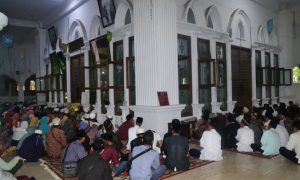Much existing commentary on supposed conservative trends in Indonesian Islam, either in media or opinion pieces, tends to forget the distinction between identity and behaviour. Particularly, there seems to be an overgeneralisation about, and interchangeability between, the concepts of religious piety (an identity) and religious intolerance and violence (behaviours).
Although such assumptions might seem intuitively true, it is important to clarify the distinction between religious piety on the one hand, and the inclination to embrace intolerant or violent behaviours on the other. In this post I will attempt to do just that. I distinguish the three main factors that are commonly subject to such overgeneralisations and conflation: the identity of religious piety, and the behaviours of both religious intolerance and religious violence.
Definition and Measurements
To begin with, it is necessary to understand what it means to be religiously pious. At an intuitive level, religious piety is most simply defined as a person’s degree of devotion to the teachings of their religion. But to understand piety within an analytical framework, we need to identify some practical indicators.
The most holistic analytical understanding of piety comes via Thomas Pepinsky, who constructs a piety index which measures the relative piety among individuals through a mix of indicators representing adherence to religious rituals, perception of religious orientation, and practice of non-obligatory religious behaviours. Other scholars, however, still rely on single indicators (between ritual, orientation, and behaviour) to define piety; usually “mosque involvement”, or “attendance of religious service”, or “support for Shari’a law”.
For the purpose of my analysis here, the indicators that are used to define piety is the frequency of practice of non-obligatory religious behaviours, such as the frequency of going to mosques for prayers and the frequency of reading the Quran, as opposed to adherence to religious rituals more generally, or self-perception of religious orientation.
Using non-obligatory religious behaviour as the measurement of piety is important particularly in Indonesia as conducting obligatory religious rituals (i.e. going to Friday prayers) is a common activity, arguably done more for social conformity than any religious drive. It is more accurate to measure behaviours that are non-obligatory, as the lack of social sanction or judgement that can be placed upon those who do not do them naturally filters out those who conduct religious practices for conformity’s sake.
My analysis also doesn’t use indicators of a person’s religious orientation (i.e. whether religion is important to them) as it is prone to fall victim to social desirability bias. Although it is also true that indicators of religious behaviours can and do also fall into such biases, the fact that the behaviours in question (reading the Quran and going to the mosque for prayers) are not obligatory, and thus not perceived to be socially expected, can give hope that people wont be as sensitive towards overreporting in answering such questions.
I am using data collected in Indonesia as part of the PEW Research Center’s Global Muslim Survey from 2012. I identified available indicators of piety, religious intolerance, and support of violence to analyse. I used crosstabulation methods to identify their correlation and chi-square tests to measure the strength of this correlation. (Data that is not taken from the PEW dataset will have a mentioned source.)
Religious Piety in Indonesia
A common supposed indicator of religious piety in Indonesia is Muslim support for the adoption of Sharia law. As accurately cited by many media articles, support for “Sharia law” in Indonesia is quite high. Data taken from survey results (such as Saiful Mujani’s 2004 research, PEW Research’s 2013 report, and SETARA’s 2016 survey on religious teachers) shows that support of Sharia Law hovers at around 70% among Muslims.
What many media and opinion articles often fail to do, however, is further substantiate what respondents mean when they say they support “Sharia”. According to the data, despite the high acceptance of Sharia law in general, when asked about specific policies that are commonly found in Sharia law, there is little support.
A 2012 PEW survey showed that out of those who supported Sharia law, only 18.3% supported the death penalty for murtad (apostates), and fewer than half supported the amputation of hands as an appropriate punishment for thieves.
A 2004 study by Saiful Mujani and R. William Liddle shows that for other regulations enshrined in Sharia law, support was also low. Only 21% of respondents believed that only Islamic parties should be allowed to run in elections, only 30% supported police supervision over fasting during Ramadhan, and only 36% supported the idea that wearing headscarves is obligatory for women.
Out of all of these findings, one can conclude that despite the fact that statistics show widespread piety in Indonesian Muslims, it does not necessarily indicate that there is overwhelming support for harsh interpretations of scripture. Despite substantial support for Sharia Law, when asked regarding its specific contents, Indonesian Muslims continue to show strong signs of rejection of violence and discrimination.
Religious Intolerance
Having understood the reality of religious piety, it is necessary to identify the actual relations between piety and religious intolerance. A common perception is that religious piety correlates positively with religious intolerance, that a person’s intolerance is caused by their religiosity, and thus to eradicate intolerance one need to counterbalance religious orthodoxy. Existing data, however, show a more nuanced and complicated relationship between the two in Indonesia.
Having adjusted for their respective population sample size, data taken from PEW Research’s 2012 Global Muslim survey indicate that, on average, the tendency for an Indonesian Muslim who reads the Quran daily (more pious) to believe Shia’s are not Muslims is 1.15 times higher than the tendency for an Indonesian Muslim who reads the Quran once or twice a month (less pious) to believe the same. In this instance, higher intolerance is positively correlated with more pious identities.
On the other hand, once we change the parameter of piety used, one can see that there is also evidence for a negative correlation between piety and intolerance. Data from the same 2012 PEW survey indicate that the tendency for an Indonesian Muslim who goes to the mosque more than once a week for prayers (more pious) to believe Shia are Muslims is 1.61 times higher than the tendency for an Indonesian Muslim who only goes to the mosques once or twice a month (less pious) to believe the same.
What this indicates is that there are inconsistent correlations between piety and intolerance, depending on what parameter of piety and tolerance one uses. At best, from the available data, we can only go as far as to say that there is no evidence to show any clear relationship between religious piety and religious intolerance.
Religious Violence
Another aspect that needs clarification is the relation between piety and religious violence. Religious violence is often perceived to have a strong positive correlation to religious piety: supposedly, those who most adhere to read and practice religious teachings are those that would be most willing to support extreme methods of defending religion.
However, this is also not backed up by survey data. From PEW’s 2012 survey, out of the 948 respondents who claim to pray in the mosque more than once a week (the most pious of respondents), only 15.6% believe that violence, such as suicide bombings, to defend Islam is just in certain circumstances. Even then, a majority of these individuals believe that such violence is only justified in rare circumstances. This means that a significant majority of pious Muslims still believe that violence in the name of religion is never just.
What is more interesting is when you compare the numbers between the more pious and less pious. Once adjusted for each of the population sample sizes and compared, data show that those who justify religious violence (such as suicide bombings) are in fact more likely to come from people who are less pious compared to those who are more pious.
The PEW 2012 survey shows the tendency for a person who goes to the mosque only once a week for Jum’ah prayers (less pious) to justify violence done in the name of Islam (i.e. suicide bombings) is 1.57 times higher than the tendency for a person who goes to the mosque more than once a week for prayers (more pious) to justify the same act. This conclusion is also consistent in other indicators of piety. The same survey also shows that the tendency for a person who reads the Quran once or twice a month (less pious) to justify violence done in the name of Islam is 1.15 times higher than the tendency for a person who reads the Quran daily (more pious) to justify the same act.
One can see that there is a clear negative relationship between both indicators of piety (frequency of going to the mosques and reading the Quran) and religious violence; violence has greater support among less pious individuals than more pious individuals.
The Islamisation of radicalism
This last conclusion, although still very preliminary, supports the idea promoted by the French scholar Olivier Roy. Roy argues that the current phenomenon of religious radicalism is not caused by the “radicalisation of Islam”, but the “Islamisation of radicalism”. What this means is that the root cause of religious violence isn’t necessarily the religious beliefs per se, but it is the violent tendencies and behaviours that had already existed and developed prior to those religious beliefs.
Roy’s research shows that a typical feature of radicalised religious youth is actually the fact that they don’t engage in a particularly religious environment. Their relationships with local mosques are ambivalent, they seem to often disrespect local imams, and their knowledge of Islamic teachings is commonly simplistic—sufficient only to support violent jihadist goals and methods.
This is not to say that, in contrast, there is a social and economic “profile” of those radicalised. A handful of violent religious individuals come from wealthy socioeconomic classes, for instance. I would merely suggest that religious piety is not necessarily the common denominator of all individuals engaging in violent behaviours in Indonesia.
Policy Implications
So what do these survey results mean? On a social level, these findings are important in erasing unchecked, rising stereotypes: that those who are pious are more prone to violent and intolerant behaviours. As stated above, data cannot provide evidence of a clear relationship between piety and intolerance. If anything, there is actually evidence of an inverse relationship between piety and violence.
On a policy level, this means that the targets and methods of deradicalisation efforts would need to not only focus on religious persuasion and pious demographic groups, as religious orthodoxy may not even be the main reason people support religious violence to begin with. To truly identify these vulnerable groups, however, it is vital to conduct further, specific research on the demography of Indonesia’s violent radical groups and their supporters. Just how many of them are driven to support these groups by religious factors such as piety, and how many more are driven by non-religious factors such as innate support towards violence (religious or not) or socio-economic dependencies and incentives?
It is completely understandable that, in times of increasing religious intolerance and violence, one takes on the most intuitive assumption. That is, that these harmful behaviours aiming to protect the “sanctity” of a particular religion are rooted in the importance of religiosity in one’s identity. However, in reality, such assumptions contain little truth. If we want to effectively deal with the religious violence and intolerance that continues to spread in Indonesia today, we need to act based on the evidence, however different it might appear from our assumptions.
……………
Alif Satria is a Research Assistant at the Centre for Strategic and International Studies in Jakarta. You can follow him on Twitter at @alifstria.
Header image courtesy of Ray Yen.
 Facebook
Facebook  Twitter
Twitter  Soundcloud
Soundcloud  Youtube
Youtube  Rss
Rss 


